Analysis of Change Management at Lakeland Wonders (MGT540 Report)
VerifiedAdded on 2023/06/08
|6
|1449
|82
Report
AI Summary
This report provides an analysis of the Lakeland Wonders case study, focusing on the management of organizational change. The report begins with an introduction to the challenges faced by the company, including employee dissatisfaction and the need for expansion. It highlights the nature of the changes as planned and outlines the reasons for these changes, such as the need for a lower-priced product line and offshore manufacturing. The report then discusses various approaches to change, including those by Van de Ven and Poole, Burns, and Alvesson & Karreman/Marshak, and organizational complexity. It details the approach followed by the company, which aligns with Burns' approach, and identifies gaps in the implemented strategy, particularly the resistance to change from stakeholders. The conclusion summarizes the key findings, emphasizing the CEO's efforts to implement change and the challenges encountered, such as the need for faster implementation. References to supporting literature are also included.
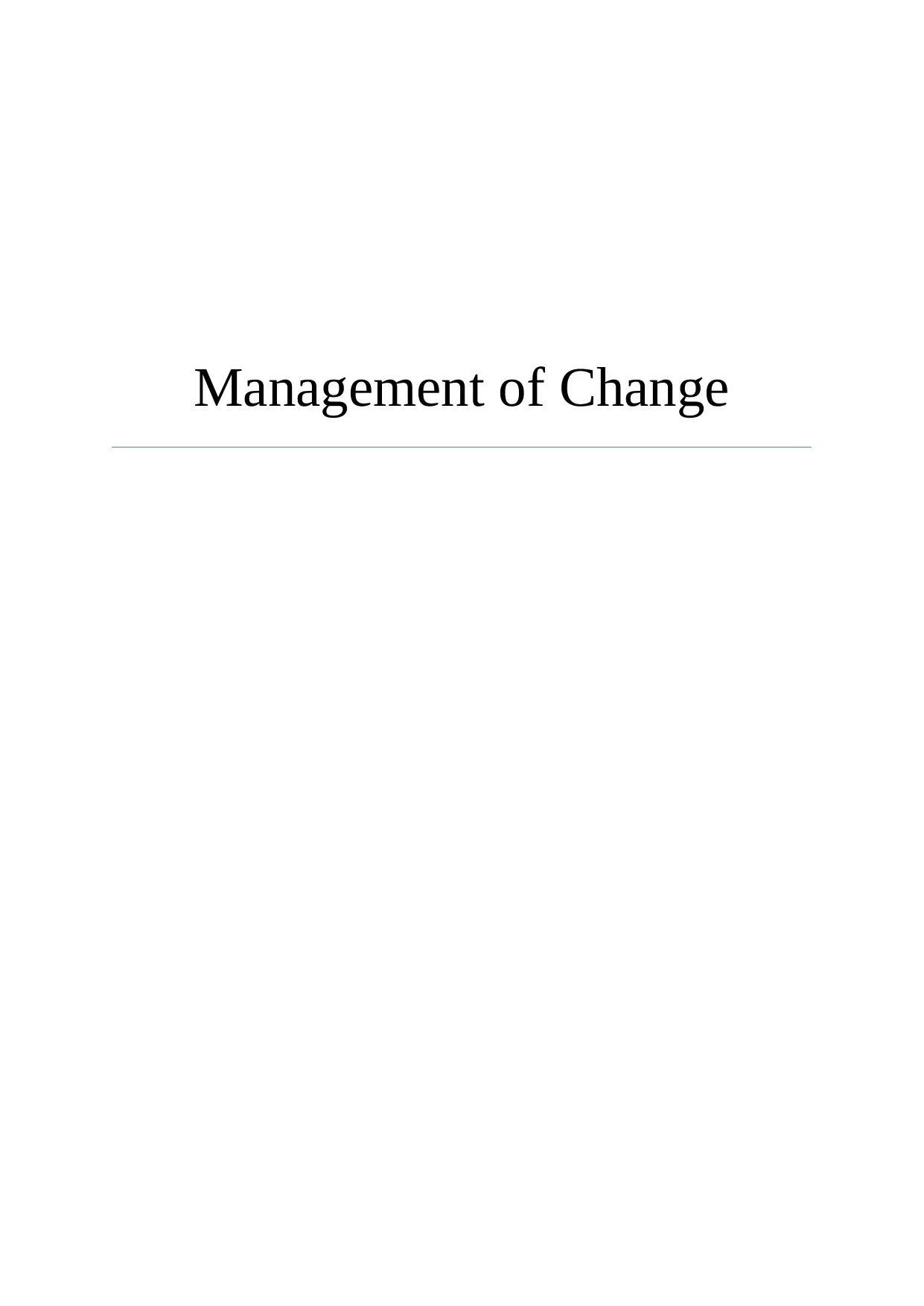
Management of Change
Paraphrase This Document
Need a fresh take? Get an instant paraphrase of this document with our AI Paraphraser
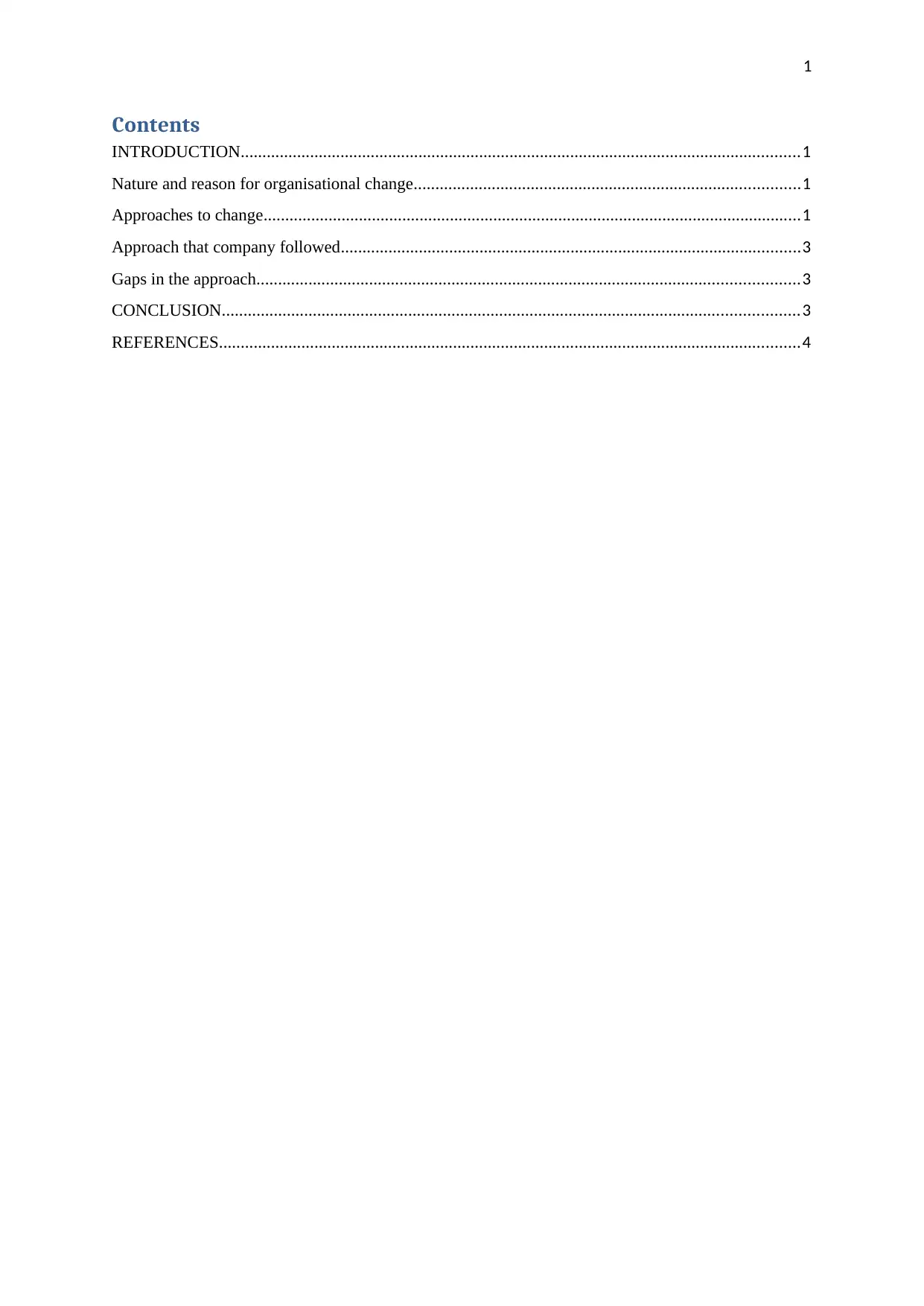
1
Contents
INTRODUCTION.................................................................................................................................1
Nature and reason for organisational change.........................................................................................1
Approaches to change............................................................................................................................1
Approach that company followed..........................................................................................................3
Gaps in the approach.............................................................................................................................3
CONCLUSION.....................................................................................................................................3
REFERENCES......................................................................................................................................4
Contents
INTRODUCTION.................................................................................................................................1
Nature and reason for organisational change.........................................................................................1
Approaches to change............................................................................................................................1
Approach that company followed..........................................................................................................3
Gaps in the approach.............................................................................................................................3
CONCLUSION.....................................................................................................................................3
REFERENCES......................................................................................................................................4
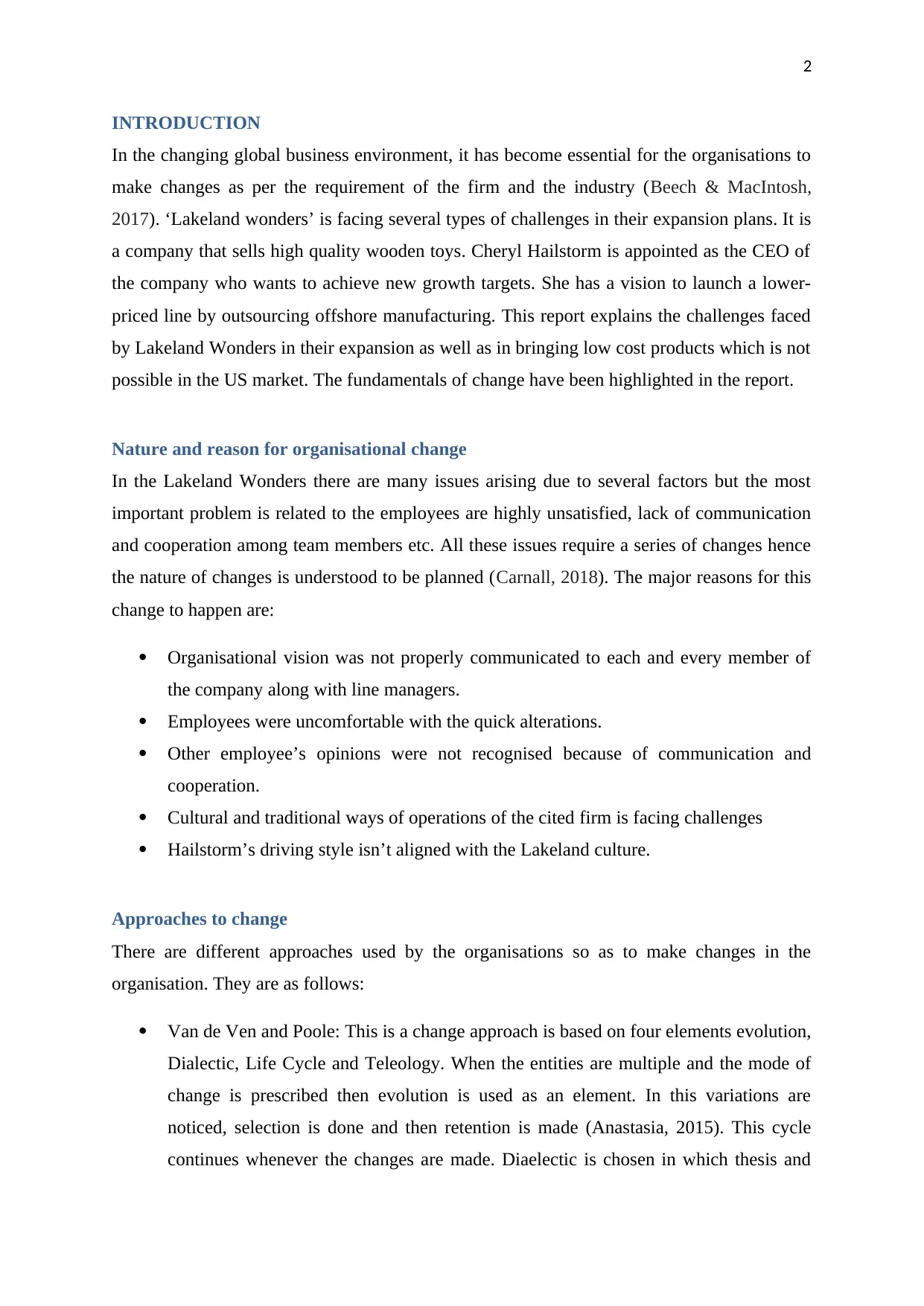
2
INTRODUCTION
In the changing global business environment, it has become essential for the organisations to
make changes as per the requirement of the firm and the industry (Beech & MacIntosh,
2017). ‘Lakeland wonders’ is facing several types of challenges in their expansion plans. It is
a company that sells high quality wooden toys. Cheryl Hailstorm is appointed as the CEO of
the company who wants to achieve new growth targets. She has a vision to launch a lower-
priced line by outsourcing offshore manufacturing. This report explains the challenges faced
by Lakeland Wonders in their expansion as well as in bringing low cost products which is not
possible in the US market. The fundamentals of change have been highlighted in the report.
Nature and reason for organisational change
In the Lakeland Wonders there are many issues arising due to several factors but the most
important problem is related to the employees are highly unsatisfied, lack of communication
and cooperation among team members etc. All these issues require a series of changes hence
the nature of changes is understood to be planned (Carnall, 2018). The major reasons for this
change to happen are:
Organisational vision was not properly communicated to each and every member of
the company along with line managers.
Employees were uncomfortable with the quick alterations.
Other employee’s opinions were not recognised because of communication and
cooperation.
Cultural and traditional ways of operations of the cited firm is facing challenges
Hailstorm’s driving style isn’t aligned with the Lakeland culture.
Approaches to change
There are different approaches used by the organisations so as to make changes in the
organisation. They are as follows:
Van de Ven and Poole: This is a change approach is based on four elements evolution,
Dialectic, Life Cycle and Teleology. When the entities are multiple and the mode of
change is prescribed then evolution is used as an element. In this variations are
noticed, selection is done and then retention is made (Anastasia, 2015). This cycle
continues whenever the changes are made. Diaelectic is chosen in which thesis and
INTRODUCTION
In the changing global business environment, it has become essential for the organisations to
make changes as per the requirement of the firm and the industry (Beech & MacIntosh,
2017). ‘Lakeland wonders’ is facing several types of challenges in their expansion plans. It is
a company that sells high quality wooden toys. Cheryl Hailstorm is appointed as the CEO of
the company who wants to achieve new growth targets. She has a vision to launch a lower-
priced line by outsourcing offshore manufacturing. This report explains the challenges faced
by Lakeland Wonders in their expansion as well as in bringing low cost products which is not
possible in the US market. The fundamentals of change have been highlighted in the report.
Nature and reason for organisational change
In the Lakeland Wonders there are many issues arising due to several factors but the most
important problem is related to the employees are highly unsatisfied, lack of communication
and cooperation among team members etc. All these issues require a series of changes hence
the nature of changes is understood to be planned (Carnall, 2018). The major reasons for this
change to happen are:
Organisational vision was not properly communicated to each and every member of
the company along with line managers.
Employees were uncomfortable with the quick alterations.
Other employee’s opinions were not recognised because of communication and
cooperation.
Cultural and traditional ways of operations of the cited firm is facing challenges
Hailstorm’s driving style isn’t aligned with the Lakeland culture.
Approaches to change
There are different approaches used by the organisations so as to make changes in the
organisation. They are as follows:
Van de Ven and Poole: This is a change approach is based on four elements evolution,
Dialectic, Life Cycle and Teleology. When the entities are multiple and the mode of
change is prescribed then evolution is used as an element. In this variations are
noticed, selection is done and then retention is made (Anastasia, 2015). This cycle
continues whenever the changes are made. Diaelectic is chosen in which thesis and
⊘ This is a preview!⊘
Do you want full access?
Subscribe today to unlock all pages.

Trusted by 1+ million students worldwide
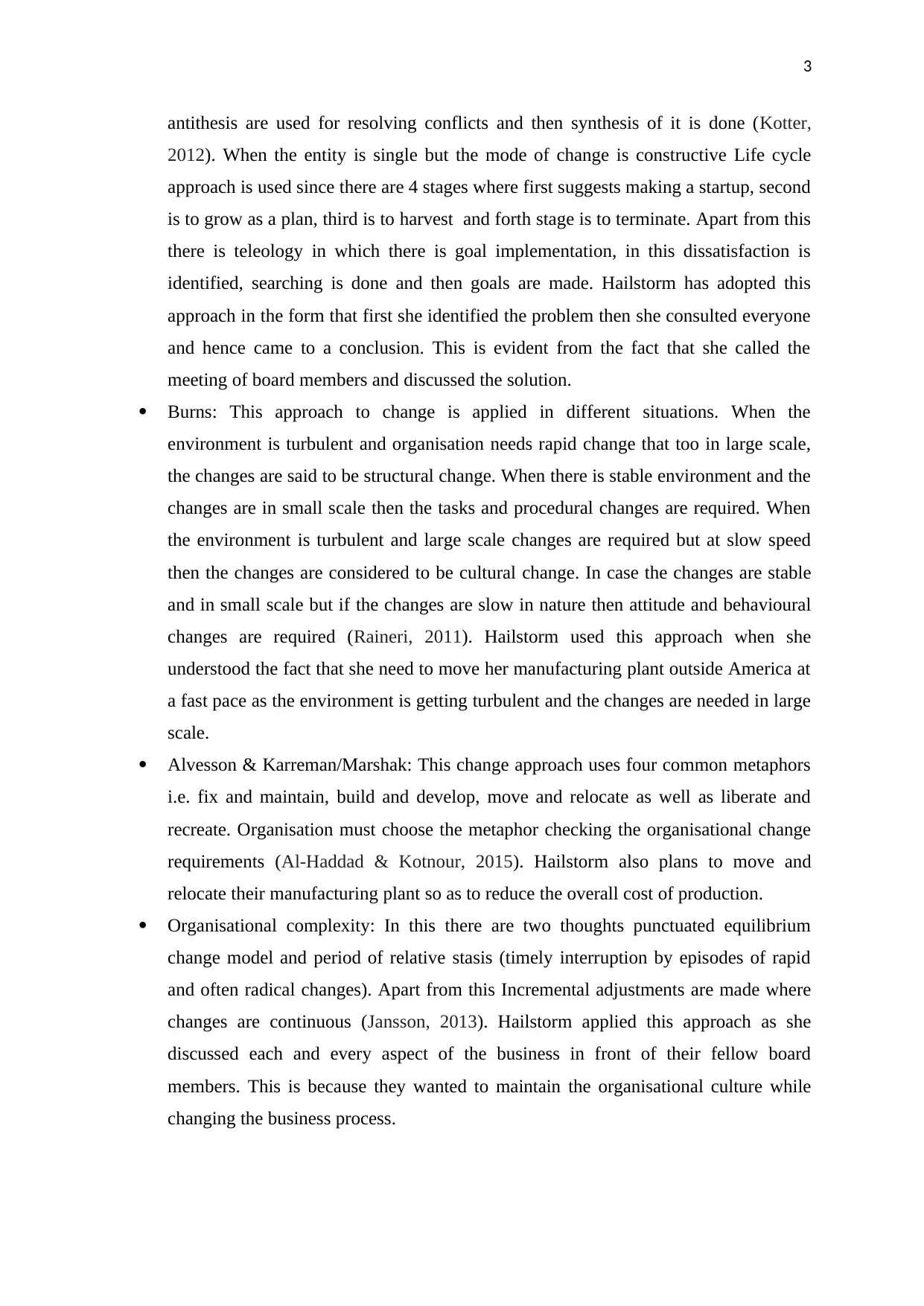
3
antithesis are used for resolving conflicts and then synthesis of it is done (Kotter,
2012). When the entity is single but the mode of change is constructive Life cycle
approach is used since there are 4 stages where first suggests making a startup, second
is to grow as a plan, third is to harvest and forth stage is to terminate. Apart from this
there is teleology in which there is goal implementation, in this dissatisfaction is
identified, searching is done and then goals are made. Hailstorm has adopted this
approach in the form that first she identified the problem then she consulted everyone
and hence came to a conclusion. This is evident from the fact that she called the
meeting of board members and discussed the solution.
Burns: This approach to change is applied in different situations. When the
environment is turbulent and organisation needs rapid change that too in large scale,
the changes are said to be structural change. When there is stable environment and the
changes are in small scale then the tasks and procedural changes are required. When
the environment is turbulent and large scale changes are required but at slow speed
then the changes are considered to be cultural change. In case the changes are stable
and in small scale but if the changes are slow in nature then attitude and behavioural
changes are required (Raineri, 2011). Hailstorm used this approach when she
understood the fact that she need to move her manufacturing plant outside America at
a fast pace as the environment is getting turbulent and the changes are needed in large
scale.
Alvesson & Karreman/Marshak: This change approach uses four common metaphors
i.e. fix and maintain, build and develop, move and relocate as well as liberate and
recreate. Organisation must choose the metaphor checking the organisational change
requirements (Al-Haddad & Kotnour, 2015). Hailstorm also plans to move and
relocate their manufacturing plant so as to reduce the overall cost of production.
Organisational complexity: In this there are two thoughts punctuated equilibrium
change model and period of relative stasis (timely interruption by episodes of rapid
and often radical changes). Apart from this Incremental adjustments are made where
changes are continuous (Jansson, 2013). Hailstorm applied this approach as she
discussed each and every aspect of the business in front of their fellow board
members. This is because they wanted to maintain the organisational culture while
changing the business process.
antithesis are used for resolving conflicts and then synthesis of it is done (Kotter,
2012). When the entity is single but the mode of change is constructive Life cycle
approach is used since there are 4 stages where first suggests making a startup, second
is to grow as a plan, third is to harvest and forth stage is to terminate. Apart from this
there is teleology in which there is goal implementation, in this dissatisfaction is
identified, searching is done and then goals are made. Hailstorm has adopted this
approach in the form that first she identified the problem then she consulted everyone
and hence came to a conclusion. This is evident from the fact that she called the
meeting of board members and discussed the solution.
Burns: This approach to change is applied in different situations. When the
environment is turbulent and organisation needs rapid change that too in large scale,
the changes are said to be structural change. When there is stable environment and the
changes are in small scale then the tasks and procedural changes are required. When
the environment is turbulent and large scale changes are required but at slow speed
then the changes are considered to be cultural change. In case the changes are stable
and in small scale but if the changes are slow in nature then attitude and behavioural
changes are required (Raineri, 2011). Hailstorm used this approach when she
understood the fact that she need to move her manufacturing plant outside America at
a fast pace as the environment is getting turbulent and the changes are needed in large
scale.
Alvesson & Karreman/Marshak: This change approach uses four common metaphors
i.e. fix and maintain, build and develop, move and relocate as well as liberate and
recreate. Organisation must choose the metaphor checking the organisational change
requirements (Al-Haddad & Kotnour, 2015). Hailstorm also plans to move and
relocate their manufacturing plant so as to reduce the overall cost of production.
Organisational complexity: In this there are two thoughts punctuated equilibrium
change model and period of relative stasis (timely interruption by episodes of rapid
and often radical changes). Apart from this Incremental adjustments are made where
changes are continuous (Jansson, 2013). Hailstorm applied this approach as she
discussed each and every aspect of the business in front of their fellow board
members. This is because they wanted to maintain the organisational culture while
changing the business process.
Paraphrase This Document
Need a fresh take? Get an instant paraphrase of this document with our AI Paraphraser
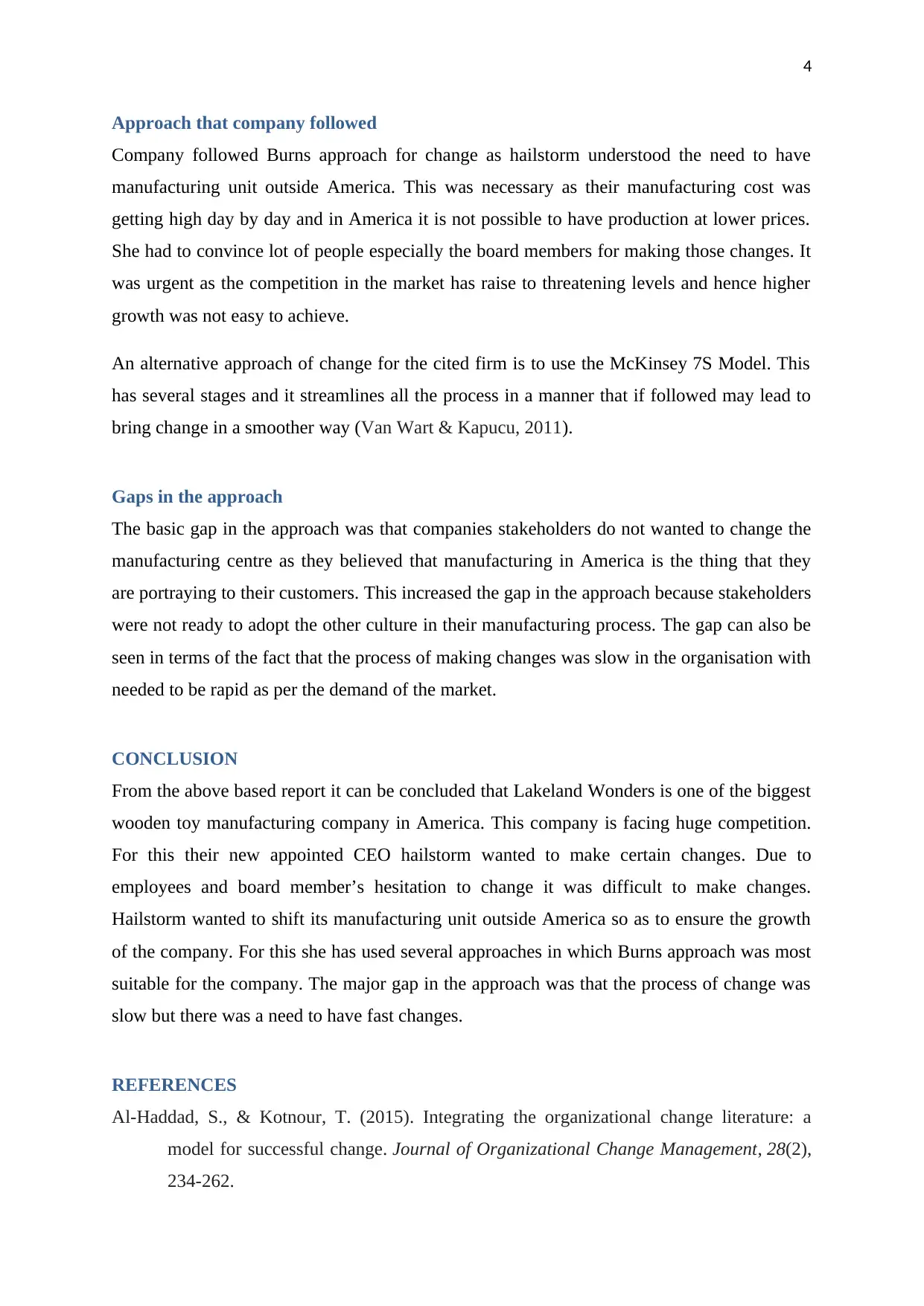
4
Approach that company followed
Company followed Burns approach for change as hailstorm understood the need to have
manufacturing unit outside America. This was necessary as their manufacturing cost was
getting high day by day and in America it is not possible to have production at lower prices.
She had to convince lot of people especially the board members for making those changes. It
was urgent as the competition in the market has raise to threatening levels and hence higher
growth was not easy to achieve.
An alternative approach of change for the cited firm is to use the McKinsey 7S Model. This
has several stages and it streamlines all the process in a manner that if followed may lead to
bring change in a smoother way (Van Wart & Kapucu, 2011).
Gaps in the approach
The basic gap in the approach was that companies stakeholders do not wanted to change the
manufacturing centre as they believed that manufacturing in America is the thing that they
are portraying to their customers. This increased the gap in the approach because stakeholders
were not ready to adopt the other culture in their manufacturing process. The gap can also be
seen in terms of the fact that the process of making changes was slow in the organisation with
needed to be rapid as per the demand of the market.
CONCLUSION
From the above based report it can be concluded that Lakeland Wonders is one of the biggest
wooden toy manufacturing company in America. This company is facing huge competition.
For this their new appointed CEO hailstorm wanted to make certain changes. Due to
employees and board member’s hesitation to change it was difficult to make changes.
Hailstorm wanted to shift its manufacturing unit outside America so as to ensure the growth
of the company. For this she has used several approaches in which Burns approach was most
suitable for the company. The major gap in the approach was that the process of change was
slow but there was a need to have fast changes.
REFERENCES
Al-Haddad, S., & Kotnour, T. (2015). Integrating the organizational change literature: a
model for successful change. Journal of Organizational Change Management, 28(2),
234-262.
Approach that company followed
Company followed Burns approach for change as hailstorm understood the need to have
manufacturing unit outside America. This was necessary as their manufacturing cost was
getting high day by day and in America it is not possible to have production at lower prices.
She had to convince lot of people especially the board members for making those changes. It
was urgent as the competition in the market has raise to threatening levels and hence higher
growth was not easy to achieve.
An alternative approach of change for the cited firm is to use the McKinsey 7S Model. This
has several stages and it streamlines all the process in a manner that if followed may lead to
bring change in a smoother way (Van Wart & Kapucu, 2011).
Gaps in the approach
The basic gap in the approach was that companies stakeholders do not wanted to change the
manufacturing centre as they believed that manufacturing in America is the thing that they
are portraying to their customers. This increased the gap in the approach because stakeholders
were not ready to adopt the other culture in their manufacturing process. The gap can also be
seen in terms of the fact that the process of making changes was slow in the organisation with
needed to be rapid as per the demand of the market.
CONCLUSION
From the above based report it can be concluded that Lakeland Wonders is one of the biggest
wooden toy manufacturing company in America. This company is facing huge competition.
For this their new appointed CEO hailstorm wanted to make certain changes. Due to
employees and board member’s hesitation to change it was difficult to make changes.
Hailstorm wanted to shift its manufacturing unit outside America so as to ensure the growth
of the company. For this she has used several approaches in which Burns approach was most
suitable for the company. The major gap in the approach was that the process of change was
slow but there was a need to have fast changes.
REFERENCES
Al-Haddad, S., & Kotnour, T. (2015). Integrating the organizational change literature: a
model for successful change. Journal of Organizational Change Management, 28(2),
234-262.
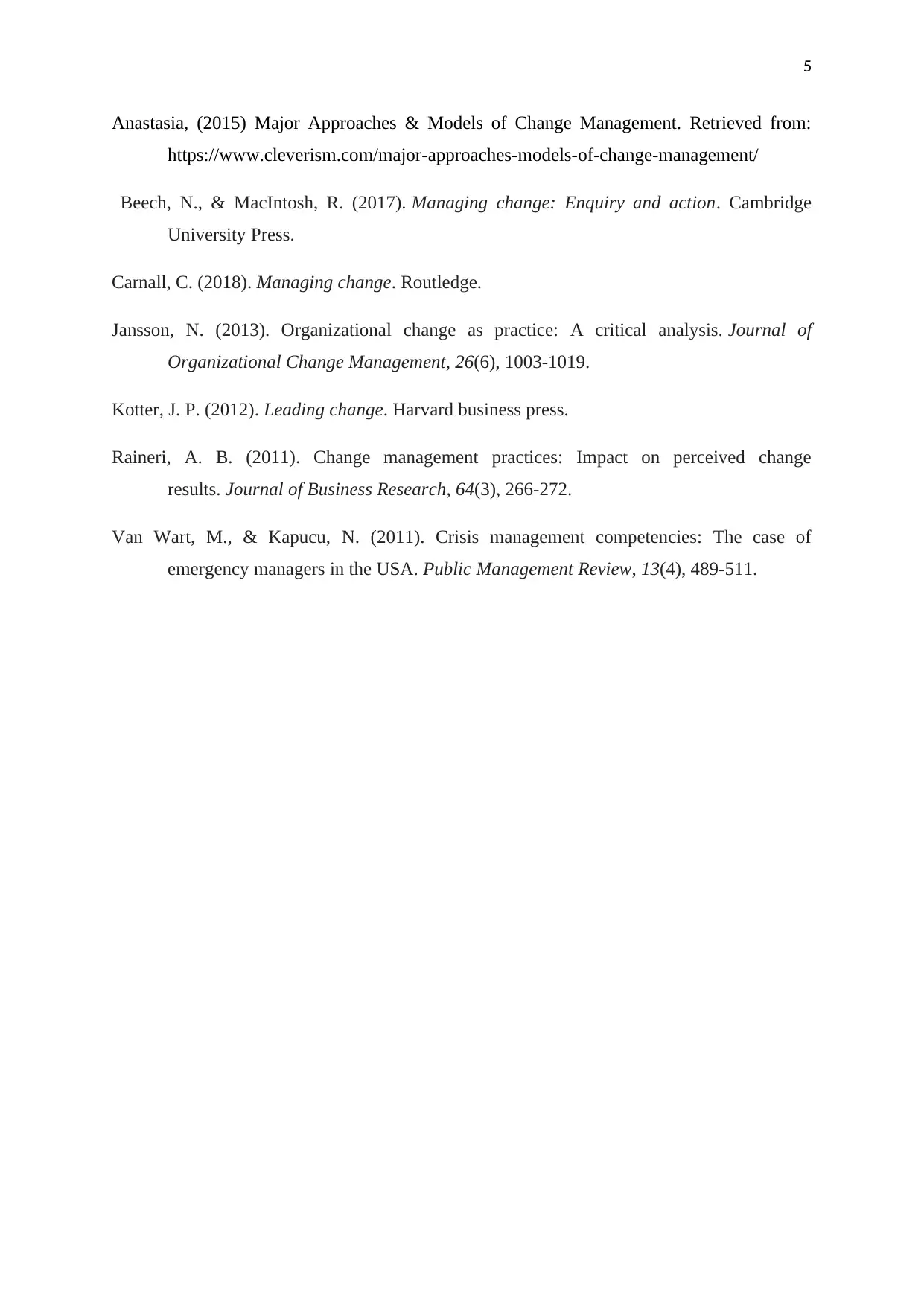
5
Anastasia, (2015) Major Approaches & Models of Change Management. Retrieved from:
https://www.cleverism.com/major-approaches-models-of-change-management/
Beech, N., & MacIntosh, R. (2017). Managing change: Enquiry and action. Cambridge
University Press.
Carnall, C. (2018). Managing change. Routledge.
Jansson, N. (2013). Organizational change as practice: A critical analysis. Journal of
Organizational Change Management, 26(6), 1003-1019.
Kotter, J. P. (2012). Leading change. Harvard business press.
Raineri, A. B. (2011). Change management practices: Impact on perceived change
results. Journal of Business Research, 64(3), 266-272.
Van Wart, M., & Kapucu, N. (2011). Crisis management competencies: The case of
emergency managers in the USA. Public Management Review, 13(4), 489-511.
Anastasia, (2015) Major Approaches & Models of Change Management. Retrieved from:
https://www.cleverism.com/major-approaches-models-of-change-management/
Beech, N., & MacIntosh, R. (2017). Managing change: Enquiry and action. Cambridge
University Press.
Carnall, C. (2018). Managing change. Routledge.
Jansson, N. (2013). Organizational change as practice: A critical analysis. Journal of
Organizational Change Management, 26(6), 1003-1019.
Kotter, J. P. (2012). Leading change. Harvard business press.
Raineri, A. B. (2011). Change management practices: Impact on perceived change
results. Journal of Business Research, 64(3), 266-272.
Van Wart, M., & Kapucu, N. (2011). Crisis management competencies: The case of
emergency managers in the USA. Public Management Review, 13(4), 489-511.
⊘ This is a preview!⊘
Do you want full access?
Subscribe today to unlock all pages.

Trusted by 1+ million students worldwide
1 out of 6
Related Documents
Your All-in-One AI-Powered Toolkit for Academic Success.
+13062052269
info@desklib.com
Available 24*7 on WhatsApp / Email
![[object Object]](/_next/static/media/star-bottom.7253800d.svg)
Unlock your academic potential
Copyright © 2020–2025 A2Z Services. All Rights Reserved. Developed and managed by ZUCOL.




